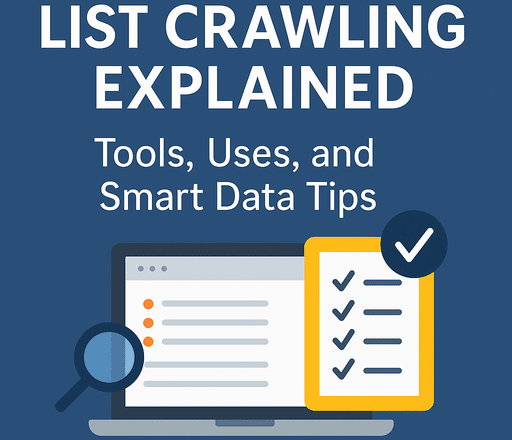If you’ve ever searched for information online and wished you could collect it all in one place, you’ve already thought about list crawling. A list crawler (sometimes called a lister crawler) is a tool or technique that helps you automatically gather data from websites—whether it’s product prices, job postings, or even list crawling dating sites where people look for profiles and matches. Unlike random web scraping, list crawl methods are focused on structured lists, making it faster, smarter, and more useful for businesses, researchers, and even everyday users.
What Is List Crawling?
List crawling is the process of automatically scanning web pages to collect data that is organized in a list format. Instead of grabbing random text from websites, a list crawler focuses only on structured information such as product listings, real estate ads, job postings, or profiles on dating platforms. A lister crawler is especially useful because it saves time and ensures accuracy compared to doing the same task manually.
In simple terms, think of list crawling as hiring a digital assistant that goes through pages one by one, collecting only the details you care about.
How Does a List Crawler Work?
A list crawler works by sending automated requests to websites and reading the HTML code behind the page. It then identifies repeating patterns such as titles, prices, or profile details. For example:
- In e-commerce, a crawler may capture product names, descriptions, and prices.
- On a job portal, it might gather job titles, locations, and salaries.
- In list crawling dating sites, it could extract profile details such as age, interests, or location.
While some crawlers require coding skills, modern lister crawler tools make the process beginner-friendly with drag-and-drop interfaces.
Popular Use Cases of List Crawling
E-commerce and Retail
E-commerce is one of the biggest areas where list crawling shows its power. A list crawler can scan hundreds of online stores and collect details like product names, prices, discounts, and customer ratings. This helps businesses stay competitive by tracking how rivals change their pricing or what new items they launch.
For example, retailers can use list crawl techniques to:
- Monitor seasonal sales across multiple platforms.
- Compare shipping costs and delivery times.
- Track which products are trending based on reviews or ratings.
Even individual shoppers can benefit from lister crawler tools. Instead of visiting every site one by one, they can pull together a list of the best deals in seconds. This makes list crawling a valuable tool not just for large businesses, but also for small sellers and bargain hunters who want to make smarter buying decisions.
Job Search
Another powerful use of list crawling is in the job market. A list crawler can scan multiple career websites, company portals, and recruitment platforms to collect job titles, descriptions, salaries, and locations—all in one organized list. Instead of spending hours browsing different sites, job seekers can save time by viewing opportunities in a single place.
For recruiters, list crawl methods are just as valuable. They can use a lister crawler to track which roles competitors are hiring for, salary ranges across industries, or even skill sets that are currently in demand. This makes it easier to design better job postings and stay ahead in recruitment strategies.
Even niche fields, such as tech or remote work, benefit from list crawling. By focusing on specialized platforms, job seekers can quickly identify the most relevant opportunities without wasting time on irrelevant listings. This targeted approach is why list crawling is becoming a must-have tool for both applicants and hiring teams.
Market Research
List crawling is also a game-changer for market research. Instead of manually gathering information from different sources, a list crawler can collect product reviews, customer feedback, pricing data, or competitor offerings in one place. Researchers and marketers can then analyze this data to spot trends, understand consumer preferences, and make better business decisions.
For example, a company could use list crawl techniques to monitor what customers are saying about competing brands, or a startup could analyze which features are most popular in a certain industry. This type of data-driven insight helps businesses stay ahead of the curve without relying only on guesswork.
Real Estate
The real estate industry generates a massive amount of data every day, and list crawling makes it easier to keep track of it all. A list crawler can scan property portals and collect details like listing prices, rental rates, property types, and availability. This allows buyers, renters, and investors to compare options across multiple websites without jumping from one platform to another.
For real estate agencies, list crawl techniques are equally valuable. They can monitor how competitors price similar properties, track changes in local housing markets, and identify new listings as soon as they go live. Whether it’s for homebuyers looking for the best deal or agencies analyzing market trends, a lister crawler provides fast, reliable insights.
Dating Platforms – List Crawling
One of the more surprising but highly relevant uses of list crawling is in the world of online dating. Dating websites and apps often contain vast amounts of structured data in the form of user profiles, interests, and demographics. A list crawler or lister crawler can be used to extract this information in a systematic way for research, marketing, or social studies.
For example, marketers might use list crawl techniques on dating platforms to understand user behavior—such as which age groups are most active, what types of profiles get the most attention, or how preferences differ across regions. Researchers can also analyze trends like relationship interests, lifestyle patterns, or even how people describe themselves in bios.
While list crawling dating websites can provide valuable insights, it’s essential to highlight the importance of privacy. Ethical crawling should focus on aggregated data and never expose personal details. When used responsibly, this approach can help businesses in the dating industry improve user experiences, fine-tune matchmaking algorithms, and identify market opportunities.
These use cases prove that list crawling isn’t just for tech experts—it’s practical for businesses, marketers, and even casual users.
Worth reading: 11 Best Free Dating & Relationship Apps for Men of All Ages
Best Tools for List Crawling
There are several tools available that make list crawl tasks simple, even without programming knowledge:
- Octoparse – Beginner-friendly, drag-and-drop crawler.
- ParseHub – Works well with complex, JavaScript-heavy websites.
- Apify – A cloud-based platform suitable for larger projects.
- Scrapy (for developers) – A Python framework ideal for advanced users.
These lister crawler tools allow anyone to collect structured data efficiently and turn it into useful insights.
Legal and Ethical Side of List Crawling
While list crawling is powerful, it’s important to use it responsibly. Always check a site’s robots.txt file to see if crawling is allowed. Avoid overloading servers with too many requests, and remember that personal or sensitive data should not be collected without consent. This is especially true in areas like list crawling dating platforms, where user privacy is critical.
Future of List Crawling
The future of list crawling is closely tied to automation and artificial intelligence. Modern list crawlers are evolving beyond simple data extraction to provide smart insights in real time. For example, instead of just collecting product prices, future crawlers will be able to analyze trends and predict changes automatically. This means businesses won’t just save time—they’ll gain a competitive advantage with actionable insights.
Why List Crawling Is Becoming Popular
The rise of list crawl technology shows how valuable structured data has become in today’s digital world. With so much information spread across websites, people need faster ways to collect and organize it. Whether it’s businesses tracking competitors, researchers collecting datasets, or even marketers exploring list crawling dating platforms for user behavior studies, the demand is clear. A lister crawler makes the impossible possible by turning scattered data into usable knowledge.
Conclusion
List crawling is no longer just a technical hobby—it’s becoming a mainstream solution for businesses, marketers, and everyday internet users. Whether you’re using a list crawler to collect prices, a lister crawler to monitor job postings, or even exploring list crawling dating sites for research, the benefits are clear: faster insights, better data, and smarter decision-making.
Frequently Asked Questions (FAQs)
Q1. What is list crawling?
List crawling is the process of collecting structured data (like product listings, job ads, or user profiles) from websites. A list crawler or lister crawler automates this process, saving time compared to manual copy-pasting.
Q2. Is list crawling legal?
Yes, list crawling is legal as long as it respects a website’s terms of service and avoids personal or restricted data. For example, list crawling dating sites for research must be handled carefully to protect user privacy.
Q3. What is the difference between a list crawler and general web scraping?
A general scraper may grab any data from a webpage, while a list crawler focuses only on structured lists, like product catalogs, job postings, or property listings. This makes list crawl results more accurate and easier to analyze.
Q4. Do I need coding skills to use a list crawler?
Not always. Many beginner-friendly lister crawler tools like Octoparse, ParseHub, and Apify allow you to perform list crawling without writing a single line of code. Developers, however, may use Python tools like Scrapy for advanced projects.
Q5. Can list crawling help with marketing?
Absolutely. Businesses use list crawling to monitor competitors, collect leads, track pricing trends, and even analyze behavior on list crawling dating platforms for insights into audience preferences.
Q6. What are the best tools for list crawling?
Some of the best tools for list crawling include Octoparse, ParseHub, and Apify for beginners, and Scrapy for developers. These list crawler tools allow you to collect structured data efficiently without much effort.
Q7. Can list crawling be used for personal projects?
Yes, a lister crawler can be very useful for personal tasks. For example, you could use list crawl techniques to gather job listings, track product discounts, or even explore list crawling dating sites to analyze trends. Just make sure you respect privacy and site policies.
Don’t miss: 11 Best Unknown Free Android Apps You’ve Never Heard Of


